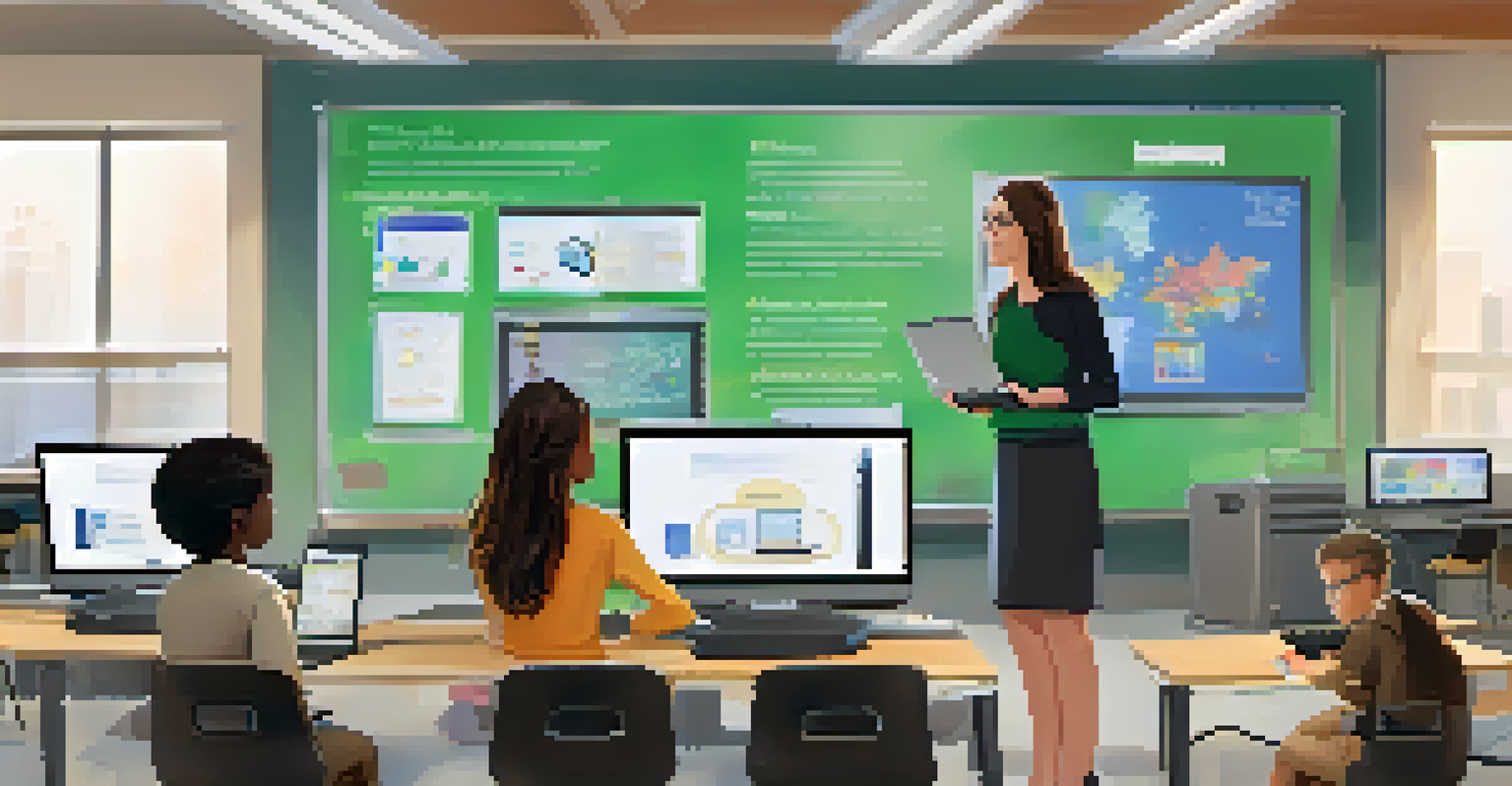Designing Curriculum for Student-Centered Learning

Understanding Student-Centered Learning Principles
Student-centered learning shifts the focus from teachers to students. In this approach, learners take an active role in their education, engaging with the material in a way that resonates with their interests and experiences. This method encourages curiosity and critical thinking, allowing students to explore topics in-depth and at their own pace.
Education is not the filling of a pail, but the lighting of a fire.
At its core, student-centered learning fosters a sense of ownership among students. When they feel empowered to make choices about their learning, they are more likely to remain engaged and motivated. This can lead to deeper understanding and retention of knowledge, as students connect new information to their personal experiences.
To effectively design a curriculum that embodies these principles, educators must prioritize flexibility and adaptability. Each student brings unique strengths and challenges, and a one-size-fits-all approach simply won’t suffice. Instead, consider how to create a curriculum that can evolve based on student feedback and performance.
Setting Clear Learning Objectives for Students
Clear learning objectives serve as a roadmap for both educators and students. By outlining what students are expected to learn, teachers can create focused lessons that guide students toward achieving those goals. This clarity helps students understand the purpose behind their activities and assessments.

When designing objectives, consider using the SMART criteria: Specific, Measurable, Achievable, Relevant, and Time-bound. For example, instead of simply stating that students will 'understand' a concept, specify that they will 'explain how photosynthesis works in their own words'. This makes expectations more tangible and actionable.
Embrace Student Ownership
Student-centered learning empowers learners to take charge of their education, fostering engagement and deeper understanding.
Involving students in the goal-setting process can further enhance engagement. Encourage them to express what they want to learn and how they would like to demonstrate their knowledge. This collaboration not only boosts motivation but also fosters a sense of accountability.
Incorporating Diverse Learning Styles and Needs
Every student has their own preferred ways of learning, often categorized into different styles such as visual, auditory, and kinesthetic. To create a student-centered curriculum, it’s essential to incorporate a variety of teaching methods that cater to these diverse needs. For instance, some students may benefit from hands-on activities, while others thrive through discussions or multimedia presentations.
Tell me and I forget, teach me and I remember, involve me and I learn.
By recognizing and accommodating these differences, educators can enhance the overall learning experience. Providing multiple avenues for interaction with the material allows students to engage in ways that feel most natural to them. This approach not only helps in grasping concepts but also boosts confidence and participation.
Additionally, consider the inclusion of students with special needs. Designing lessons with Universal Design for Learning (UDL) principles in mind ensures that all students have equitable access to the curriculum. This might include offering different formats for assignments or providing assistive technologies.
Fostering Collaboration and Peer Learning Opportunities
Collaboration is a cornerstone of student-centered learning. By encouraging students to work together on projects and assignments, they can learn from one another’s perspectives and strengths. This not only builds essential teamwork skills but also creates a sense of community within the classroom.
Group activities can range from collaborative problem-solving tasks to peer teaching sessions. For instance, having students explain concepts to their classmates reinforces their understanding while also enhancing communication skills. Such interactions often lead to deeper insights and a richer learning experience.
Diverse Learning Approaches Matter
Incorporating various teaching methods addresses the unique learning styles of students, enhancing their overall experience.
Moreover, fostering a collaborative environment helps students develop critical social skills. They learn to negotiate, compromise, and respect differing opinions, which are invaluable both in and out of the classroom. By prioritizing collaboration, educators can create a more dynamic and engaging learning atmosphere.
Integrating Technology for Enhanced Learning Experiences
Technology plays a pivotal role in modern student-centered learning. With tools like interactive software, online resources, and educational apps, educators can provide students with engaging materials that cater to their interests. This not only makes learning more enjoyable but also prepares students for a tech-savvy world.
For example, using platforms like Google Classroom allows for seamless communication and collaboration among students. They can share resources, provide feedback, and work together on projects in real-time, regardless of their physical location. This flexibility supports diverse learning preferences and schedules.
Moreover, technology offers opportunities for personalized learning. Adaptive learning programs can assess student performance and tailor content to meet individual needs, ensuring that each student progresses at their own pace. By integrating technology thoughtfully, educators can create an enriched and responsive learning environment.
Assessment Strategies for Student-Centered Learning
Assessment in a student-centered curriculum should extend beyond traditional tests and quizzes. Instead, consider a variety of assessment methods that allow students to demonstrate their understanding in multiple ways. This could include portfolios, presentations, or even creative projects, giving students the chance to showcase their knowledge effectively.
Formative assessments, conducted throughout the learning process, offer valuable insights into student progress. These can be informal checks for understanding, such as exit tickets or quick reflections, that help educators adjust their teaching strategies as needed. This ongoing feedback loop ensures that students remain on track and engaged.
Continuous Curriculum Improvement
Regular evaluation and feedback ensure that the curriculum remains relevant and effectively meets students' evolving needs.
Moreover, involving students in the assessment process can be empowering. Encouraging self-assessment and peer reviews helps students reflect on their learning journey and take ownership of their progress. This practice not only enhances accountability but also fosters a growth mindset.
Creating a Supportive Learning Environment
A supportive learning environment is crucial for fostering student-centered learning. This means creating a classroom atmosphere where students feel safe, respected, and valued. When students know their voices are heard and their contributions matter, they are more likely to engage actively in their learning.
Building strong relationships with students is fundamental to this process. Take the time to understand their individual interests and backgrounds, which can help tailor lessons that resonate with them on a personal level. The more connected students feel, the more invested they will be in their education.

Additionally, establishing clear expectations and routines can further enhance the learning environment. When students know what to expect, they are more likely to feel comfortable taking risks and participating in discussions. A nurturing atmosphere lays the groundwork for effective student-centered learning.
Evaluating and Refining the Curriculum Continuously
Curriculum design is not a one-time effort; it requires ongoing evaluation and refinement. Gathering feedback from students about their learning experiences can provide valuable insights into what is working and what needs improvement. Regular check-ins allow educators to adjust their approaches to meet the evolving needs of their students.
Incorporating data from assessments is another critical component. Analyzing student performance trends helps identify gaps in understanding and informs future curriculum adjustments. This data-driven approach ensures that the curriculum remains relevant and effective.
Ultimately, fostering a culture of continuous improvement benefits everyone involved. Educators, students, and parents all play a role in shaping a dynamic learning environment. By remaining open to change and innovation, educators can ensure that their student-centered curriculum meets the highest standards of excellence.